Biblijne obrazy Kościoła w pismach świętej Faustyny
DOI:
https://doi.org/10.15633/ps.29305Słowa kluczowe:
Dom Boży, Kościół, Święta Faustyna, wspólnota, „Dzienniczek”Abstrakt
Kościół założony przez Jezusa Chrystusa jest rzeczywistością bardzo złożoną. Dlatego można patrzeć na niego w wielu wymiarach. Niestety, we współczesnym świecie dominuje niepełny obraz tej niezwykłej wspólnoty, gdzie dostrzega się tylko instytucję, a zapomina o jej duchowym wymiarze. W takiej sytuacji, z pomocą przychodzi nam święta Faustyna, która dzięki mistycznemu doświadczeniu przekazała w „Dzienniczku” właściwy obraz Kościoła. Można dostrzec, że Kościół to przede wszystkim wspólnota żywych członków Chrystusa, złączonych duchową więzią. Apostołka Bożego miłosierdzia ukazuje, że ta wspólnota jest domem Pana, a Kościół w relacji do wiernych jest jak matka, która żywi i opiekuje się swymi dziećmi. Niezaprzeczalną pomocą na drodze wzrastania są oczywiście sakramenty święte, które dają możliwość oczyszczenia i uzyskania na nowo łaski Bożej. Taki obraz, zawarty w „Dzienniczku”, pomaga człowiekowi we właściwy sposób patrzeć na Kościół i w niego wierzyć.
Bibliografia
Bartnik Cz. S., Dogmatyka katolicka, Lublin 2012.
Buscemi A. M., San Paolo. Vita, opera, messaggio, Jerusalem 1997.
Cyprian z Kartaginy, De unitate Ecclesiae, w: św. Cyprian, Pisma, tłum. J. Czuj, s. 171–193 (Pisma Ojców Kościoła, 19).
Fabris R., Matteo. Traduzione e commento, Roma 1996.
Flis J., List do Filipian, Częstochowa 2011 (Nowy Komentarz Biblijny. Nowy Testament, 11).
Grzechowiak S., Kościele, kim jesteś? Studium eklezjologii, Gniezno 2002.
Haręzga S., Pierwszy i Drugi List do Tymoteusza, List do Tytusa, Częstochowa 2018 (Nowy Komentarz Biblijny. Nowy Testament, 14).
Jagodziński M., Kościół komunii, Kraków 2022 (Myśl Teologiczna, 110).
Jan Paweł II, Adhortacja Christifideles laici, 30.12.1988.
Jan Paweł II, Encyklika Redemptor hominis, 04.03.1979.
Jan Paweł II, Posynodalna adhortacja Vita consecrata, 25.03.1996.
Jan XXIII, Encyklika Mater et Magistra, 15.05.1961.
Jezierska E. J., Kościół — domem chrześcijan, „Wrocławski Przegląd Teologiczny” 20 (2012) nr 2, s. 35–43.
Katechizm Kościoła katolickiego, Poznań 1994.
Kowalska F., Dzienniczek. Miłosierdzie Boże w duszy mojej, Kraków 2020.
Machniak J., Modlę się ciszą. Spotkania ze świętą Faustyną Kowalską, Kraków 2000.
Machniak J., Najuroczystsza chwila. Eucharystia w życiu św. siostry Faustyny Kowalskiej, Kraków 2004.
Morawa J., Znaki prawdziwości Kościoła, w: Kościół Chrystusowy, red. T. Dzidek, Ł. Kamykowski, A. Napiórkowski, Kraków 2019, s. 73–137 (Teologia Fundamentalna, 4).
Neuner P., Eklezjologia — nauka o Kościele, w: F. Courth, P. Neuner, Mariologia. Eklezjologia, red. W. Beinert, Z. Kijas, Kraków 1999 (Podręcznik Teologii Dogmatycznej, 6).
Novum Testamentum Graece, Hrsg. E. Nestle, E. Nestle, K. Aland, J. Karavidopoulos, C. M. Martini, B. M. Metzger, Stuttgart 2012 (Nestle-Aland, 28).
Paciorek A., Ewangelia według świętego Mateusza, rozdziały 14–28, Częstochowa 2008 (Nowy Komentarz Biblijny. Nowy Testament, 1/2).
Pié-Ninot S., Wprowadzenie do eklezjologii, tłum. T. Kukułka, Kraków 2007 (Myśl Teologiczna, 34).
Pismo Święte Nowego Testamentu. Biblia Tysiąclecia, Poznań 2015.
Pius XII, Encyklika Mystici corporis o Mistycznym Ciele Jezusa Chrystusa i o naszym w nim zjednoczeniu z Chrystusem, 29.06.1943.
Rebeta W., Misterium cierpienia świętej Faustyny, Lublin 2014.
Rosik M., Pierwszy List do Koryntian, Częstochowa 2009 (Nowy Komentarz Biblijny. Nowy Testament, 7).
Rusecki M., Traktat o Kościele, Lublin 2015.
Seweryniak H., Święty Kościół powszedni, Warszawa 1999.
Siwecki L., Eklezjologia, w: Dogmatyka w perspektywie Bożego Miłosierdzia, red. K. Góźdź, K. Gózowski, Lublin 2010, s. 147–161.
Sobór Watykański II, Konstytucja dogmatyczna o Kościele Lumen gentium, 16.11.1964.
Urbański S., Życie mistyczne błogosławionej Faustyny Kowalskiej, Warszawa 1997.
Zalewski D., Domue ecclesiae — chrześcijańskie miejsce kultu, „Studia Ełckie” 17 (2015) nr 2, s. 139–148.
Żywica Z., Szymon Piotr znakiem trwania i jedności Jezusowego Kościoła Żydów i Greków według Mt 16, 13–20, „Studia Nauk Teologicznych” 10 (2015), s. 15–30, https://doi.org/10.24425/snt.2015.112794.
Pobrania
Opublikowane
Numer
Dział
Licencja
Prawa autorskie (c) 2025 Sławomir Czajka

Utwór dostępny jest na licencji Creative Commons Uznanie autorstwa 4.0 Międzynarodowe.
Autorzy publikujący w czasopiśmie udzielają jego wydawcy zgody o następującej treści:
- Autor zachowuje autorskie prawa majątkowe do utworu, a jednocześnie udziela wydawcy czasopisma zgody na jego pierwszą publikację w wersji drukowanej i wersji online na licencji Creative Commons Uznanie autorstwa 4.0 Międzynarodowe oraz zgody na wykonywanie opracowań, w tym przekładów.
- Autor ma możliwość udzielania zgody niewyłącznej na opublikowanie utworu w wersji, która ukazała się w czasopiśmie (np. zamieszczenia go w repozytorium instytucjonalnym lub opublikowania w książce), wraz z informacją o jego pierwszej publikacji w czasopiśmie.
- Autor może umieścić swój utwór online (np. w repozytorium instytucjonalnym lub na swojej stronie internetowej) jeszcze przed zgłoszeniem utworu do czasopisma.

